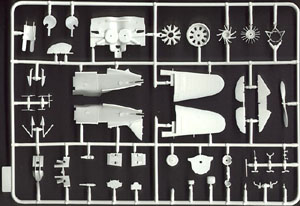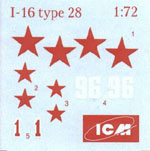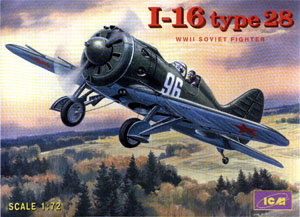History The I-16 is a very well known aircraft. When it was first brought out, the West thought it was a copy of the Boeing P-26; turns out the fighter was everything but. Light and nimble, it turned out to be an exceptional single-seat fighter for its time, much better than anything in the West at that time. Earning its "teeth" in the Spanish Civil War (SCW), the I-16 soldiered on through the early stages of the Great Patriotic War (WW2). In the right hands, the I-16 was better than the early versions of the Bf-109. The Kit The ICM I-16 Type 28 contains 53 injected plastic pieces with two clear injected pieces comprising the windscreen and the gun sight. This kit is identical to the Type 24 reviewed earlier. In fact, the only differences in the boxings are the decals, the instructions and the level of quality. It would appear that ICM has been listening to us and improved the quality of their kits. The Type 24 I reviewed last time has some deep sink “marks” in the leading edge of the wing, in the small extension that partly attaches to the fuselage. These don’t exist on the kit of the Type 28 I have, instead only being slightly “sunken” and will easily be eradicated with a couple of swipes of the sandpaper.  Like the Type 24 the Type 28’s windscreen is not accurate. The best bet is to either obtain the Falcon vacuform canopy set that includes an I-16 windscreen, or “squash cast” your own from a Hasegawa master. In addition, the Type 28 fails in a couple of other areas. In “lineage” terms, the Type 28 (and –27 for that matter) was derived from the Type 17, while the Type 24 was derived from the –18. That means the starboard cockpit entry door outline should be filled in. However, since the –28 came out as late as it did, it’s doubtful the radio door – at the rear of the fuselage on the starboard side – should be left as is. Like the Type 24 the Type 28’s windscreen is not accurate. The best bet is to either obtain the Falcon vacuform canopy set that includes an I-16 windscreen, or “squash cast” your own from a Hasegawa master. In addition, the Type 28 fails in a couple of other areas. In “lineage” terms, the Type 28 (and –27 for that matter) was derived from the Type 17, while the Type 24 was derived from the –18. That means the starboard cockpit entry door outline should be filled in. However, since the –28 came out as late as it did, it’s doubtful the radio door – at the rear of the fuselage on the starboard side – should be left as is.
The major difference between the Type 24 and the Type 28 resides in the wing guns. The Type 24 had the ShKAS machine guns mounted, while the Type 28 had the ShVAK cannons. One thing ICM left off their instructions is that you have to snip off the molded-in ShKAS and replace them with the separate ShVAK (parts 20 on the sprue). In fact, these ShVAK guns are on the Type 24 sprue, but I never truly noticed them until the Type 28 was released. While the sides of the cockpit contain no detail at all, the floor/seat-back combination is accurate having the correct cutouts. Rounding out the kit-supplied cockpit is a control column, rudder pedals, seat bucket and instrument panel. My plan is to use the exceptional Part photoetch set, which includes sidewall detail as well as other cockpit parts (see Michael Kendix’s review where he used the Part set on the Type 24). The engine is extremely well done, containing not only a complete engine, but also most of the structure behind it and the “plumbing” in the front to make an extremely accurate engine bay area. Astute builders may want to leave off one or two of the separate cowl pieces to display a superdetailed engine, which ICM gives you a great start with.  In looking how the cowl pieces go together, there could be other I-16 types coming down the pike from ICM. I personally think it will be awesome to see a Type 29, as there hasn't been a kit of it yet in 1/72nd. In looking how the cowl pieces go together, there could be other I-16 types coming down the pike from ICM. I personally think it will be awesome to see a Type 29, as there hasn't been a kit of it yet in 1/72nd.
The wings are one piece, attaching to the fuselage assembly at the joint-line, as well as the other metal portions of the inner wing. The rudder and stabilizers are separate pieces and may be displayed deflected. In fact, if you so desire you may be able to have these pieces move. Conclusion Even though this is basically a “re-release” of the Type 24 kit, the level of quality has improved, and this time ICM molds the kit in an off-white, versus gray of the Type 24. There are two decal choices, one a machine of the Baltic Fleet – “White 99” – and the other is a machine of the 158 IAP – “Red 1”. If you haven’t bought the Type 24 yet, then I would opt for the Type 28 instead, and just keep the molded in ShKAS machine guns. However, while the Type 28 only comes with decal options for two machines, the Type 24 comes with decals for nine machines, all Type 24s. Not a problem, though, if you have other decals for the I-16. If one were inclined, one could either modify the spinner or take one from the Hasegawa Type 18 to produce a Type 27. Or if one were truly adventurous, one could modify the kit into a Type 17 by sanding off the upper air intake on the cowl, replace the spinner with the more “pointy” type, fill in the starboard cockpit door, and fill in the radio door on the rear fuselage on the starboard side. Not terribly daunting. In fact, making the kit into a Type 18 is also easy by modifying the spinner and keeping the molded on ShKAS guns. |


 




|
